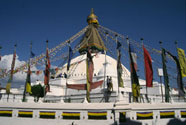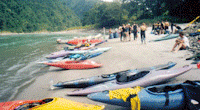What is Nepal like?
 Tucked away between India and the Tibetan Plateau, Nepal is dominated by the towering Himalayas - a majestic range of snowy giants standing guard over the stunning beauty of our country.
Tucked away between India and the Tibetan Plateau, Nepal is dominated by the towering Himalayas - a majestic range of snowy giants standing guard over the stunning beauty of our country.
Thanks to these huge mountains, Nepal enjoys the widest range of altitude of any country in the world. Altitudes vary from as little as 70m on the Terai plains to Mount Everest’s colossal peak at 8848m. As a result, our vegetation zones include tropical, subtropical, temperate and alpine areas.
In these diverse natural environments an incredible range of flora and fauna flourish, attracting nature lovers all year round. Nepal is an ornithologist’s paradise, with over 800 species of birds, including storks, pheasants, cuckoos and enormous birds of prey. For those who prefer larger animals, a visit to one of the National Parks could reward you with a sighting of our famous royal Bengal tigers, bears or one horned rhino. You do not have to go far to see the monkeys, many of whom live side by side with the residents of towns and villages!
Neither do you need to go to a museum to find evidence of Nepal’s long and fascinating history: it’s all around you in the towns and villages that dot the Kathmandu valley and lie hidden in the mountain ranges. Villages where everyday life still follows long established traditions, and where time almost seems to have stood still.
The Nepalese are naturally a friendly, welcoming people. We enjoy meeting people from around the world, and are proud to share our wonderful country with you. Visitors to Nepal often return time and time again, drawn by the stunning scenery, the warm and smiling people, the outdoor adventure and the special atmosphere that pervades the clear mountain air.
Nepal Infact
Location/Geography:
Nepal covers an area of 147,181 square kilometers, and stretches 145-241 kilometers north to south and 850 kilometers west to east. The country is located between India in the south and China in the north. At latitudes 26 and 30 degrees north and longitudes 80 and 88 degrees east, Nepal is topographically divided into three regions: the Himalaya to the north, the hills consisting of the Mahabharat range and the Churia Hills, and the Terai to the south. Elevations are varied in the kingdom. The highest point is Mt. Everest (8848 m) in the north and the lowest point (70 meters above sea level) is located at Kechana Kalan of Jhapa District. Altitude increases as you travel south to north To the north temperatures are below - 40 degrees Celsius and in the Terai, temperatures rise to 40 degrees Celsius in the summer. During June, July and August, the kingdom is influenced by monsoon clouds.
Language:
Nepali is the national language of Nepal. Though many languages are used throughout the country, most people understand and speak Nepali. Educated people, and those involved in the tourist industry also understand and speak English.
Time:
Nepal Time is 5 hours 45 minutes ahead of GMT and 15 minutes ahead of Indian standard time.
Money:
Nearly all money in Nepal is in the form of notes. The Nepalese rupee is linked to the Indian rupee, but its value fluctuates against all other major currencies. For the date of 21 July 2013 there were 95.00 rupees to the dollar, 123.00 rupees to Euro and 144.00 rupees to the pound sterling. Travelers' cheques are accepted at all exchange counters. Credit cards (Visa and Master Card) are accepted in shops and restaurants in major cities. Withdrawing money with a credit card is possible through banks and cash mashines (ATM) in major cities. Please, note that for the trips outside the cities is recommended to carry cash in nepalese rupees.
Climate & when to go:
It's hard to generalize about the climate of a country ranging in elevation from near sea level to Mount Everest. About the only thing that can be said is that all but a few parts of Nepal are governed by the same monsoon pattern, with temperatures varying according to elevation. Five seasons prevail in Nepal, but these are not mere meteorological divisions: when-ever you choose to go, you'll have to weigh weather against other factors, both positive (mountain visibility, festivals, wildlife) and negative (crowds, disease).
Probably half of all tourists visit Nepal in the Autumn (October to November), and for good reasons. The weather is clear and dry, and temperatures will not too cold in the high country nor too hot in the Tarai. with the air washed clean by the monsoon rains, the mountains are at their most visible, making this the most popular time for trekking. Two major festivals also fall during this season. The downside, however, is that the tourist quarters are heaving and hustly, it's hard to find a decent room, you'll waltages for food and for trekking permits, and people are short on ready smiles and chat.
In winter (December and January), the snow line descends to 2.000 - 3000m and though it never snows in Kathmandu, the "mists of India" make the capital feel cold and clammy (especially in unheated budget lodgings). Most travelers head down into India, leaving the trekking routes and guest houses fairly quiet too quiet, sometimes, as many restaurants pare down their menus for the season.
 Monsoon of Nepal Spring (February to mid-April) brings warmer temperatures, longer days, weddings and more festivals. The rhododendrons are in bloom in the hills towards the end of this period, and in the Tarai the thatch has been cut, making this the best time for viewing wildlife. All of which creates another tourist crush, albeit not quite as bad as in the autumn. The one factor that keeps people away is a disappointing haze that obscures the mountains from lower elevations, though it's usually possible to trek above it. The pre-monsoon (mid-April to early June) is stifling at lower elevations, and dusty wind squalls are common. People get a little edgy with the heat; this is the time for popular unrest, but also for the Kathmandu Valley's great rain-making festival. Trek high, where the temperatures are more tolerable.
Monsoon of Nepal Spring (February to mid-April) brings warmer temperatures, longer days, weddings and more festivals. The rhododendrons are in bloom in the hills towards the end of this period, and in the Tarai the thatch has been cut, making this the best time for viewing wildlife. All of which creates another tourist crush, albeit not quite as bad as in the autumn. The one factor that keeps people away is a disappointing haze that obscures the mountains from lower elevations, though it's usually possible to trek above it. The pre-monsoon (mid-April to early June) is stifling at lower elevations, and dusty wind squalls are common. People get a little edgy with the heat; this is the time for popular unrest, but also for the Kathmandu Valley's great rain-making festival. Trek high, where the temperatures are more tolerable.
Nepal welcomes the Monsoon (June to September), which breaks the enervating monotony of the previous months, and makes the fields come alive with rushing water and green shoots. The rains rinse and renew the land. This can be a fascinating time to visit, when Nepal is at its most Nepali, but there are many drawbacks: mountain views are rare, leeches come out in force along the mid-elevation trekking routes, roads wash out, flights get canceled, and disease runs rampant as the rising water table brings the entire contents of Kathmandu's sewers to the surface.
People, culture and Religion:
Nepalese people are mainly divided into two distinct groups, the Indo-Aryans and the Mongoloids. Kathmandu Valley is the spiritual and cultural meeting point of all these groups.
Religious practices are an important part of the lives of the Nepalese people. Mythologies of various Hindu gods and goddesses abound in this country and cultural values are based on the philosophies of holy books like the Swasthani Gita, Ramayana etc.
Women and children visit neighborhood shrines at dawn to offer worship to the gods. Holding plates of rice, flowers, and vermilion powder, they perform puja by lighting incense, ringing the temple bell, and applying tika, a red paste, on their foreheads. Passers by stop at temples and show their reverence to the gods by spending a few minutes praying. Occasionally, groups of men sit near temples playing music and singing hyms until late night.
In Nepal, Hinduism and Buddhism are the two main religions. The two have co-existed down the ages and many Hindu temples share the same complex as Buddhist shrines. Hindu and Buddhist worshipers may regard the same god with different names while performing religious rites.
Though Nepal is the only Hindu Kingdom in the world, many other religions like Islam, Christianity, and Bon are practiced here. Some of the earliest inhabitants like the Kirats practice their own kind of religion based on ancestor worship and the Tharus practice animism. Over the years, Hinduism and Buddhism have been influenced by these practices which have been modified to form a synthesis of newer beliefs.
As a result, visitors to this country may often find the religious practices in Nepal difficult to follow and understand. But this does not prevent one from enjoying the idifferent traditional ceremonies and rituals of Nepalese culture. It is indeed a totally new experience of religious fervor.
Hinduism :
Thousands of gods and goddesses make up the Hindu pantheon. Brahma, Vishnu, and Shiva are he three major Hindu gods who have heir own characteristics and incarnations. Each god has his own steed which is often seen kneeling faithfully outside that god's temple. Symbolic objects are carried by the multiple ands of each deity which empowers them to perform great feats.
Buddhism :
Sakyamuni Buddha is the founder of Buddhism who lived and taught in this part of the world during the sixth century BC. The great stupas of Swayambhunath and Bouddhanath are among the oldest and most beautiful worship sites in the Kathmandu Valley.
The spinning of prayer wheels, prostrating pilgrims, collective chants and burning butter lamps are some Buddhist practices often encouithtered by tourists. A slip of paper bearing a mantra is kept inside the wheels so that prayers are sent to the gods when the wheel is spun. Scenes from the Buddha's life and Buddhist realms are depicted on thangka scroll paintings which are used during meditation and prayer ceremonies. Many Buddhist followers are seen performing these practices in Swayambhunath, Boudanath, and at other Buddhist sites around the Valley.
Entry Procedures:
Nepalese entry procedures change frequently. As for the year 2009 (according to new visa rules 16 July, 2008) you can obtain tourist visa on your arrival to Nepal:
- Multiple entry visa for 15 days or less from the date of entry US$ 25 or equivalent convertible foreign currency.
- Multiple entry visa for 30 days US$ 40 or equivalent convertible foreign currency.
- Multiple entry visa for 90 days US$ 100 or equivalent convertible foreign currency.
It is recommended to check prior to arriving in Nepal what the current procedure is and also to bring at least one passport photo with you if you intend arranging your visa on. (Carry all necessary documentation in your hand luggage.)
Entry Points:
By Air:
Tribhuvan International Airport, Kathmandu.
By Bus:
(1) Kakarbhitta (2) Birgunj (3) Belhiya (Bhairahawa) (4) Nepalgung (5) Dhangadi (6) Jogbani (Biratnagar) and (7) Mahendra Nagar in Nepal-India border and (8) Kodari in Nepal-China border. The overland tourists entering the kingdom with their vehicles must possess an international carnet.


